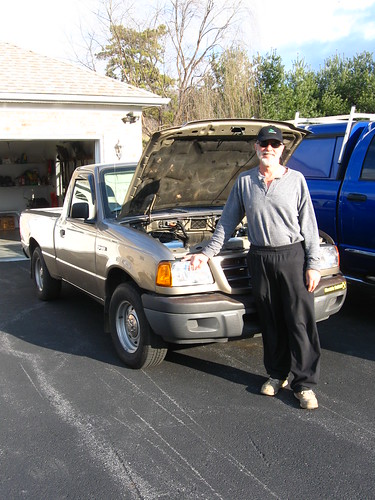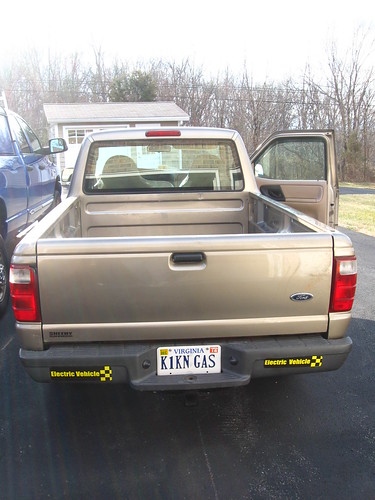
On the outside it looks like an ordinary 2003 Ford Ranger 2.3L 5 speed with a regular cab...
I was heading out of my neighborhood Saturday morning when David Waterman asked me: "Do you want to ride in my electric truck?" The answer should be obvious. David opened the hood, revealing the lack of a gasoline engine, radiator and exhaust manifold. Instead, a 150 pound WarpNine electric motor from NetGain is seated in place of the conventional engine. An adapter kit allows it to be attatched to the Ford drive shaft.
48 lithium ion cells provide power. A device called a controller regulates power to the motor. It is mounted up near the firewall and is a beautiful piece of milled aluminum with cooling fins.
David designed the vehicle around his driving needs. At 120 volts it takes 20 hours to put on a full charge. A full charge costs about $3.00 and the estimated range with all cells healthy is around 100 miles. That's a 'fuel cost' of three cents per mile!
A business such as an auto parts warehouse might provide a charging station so the trucks can be charged every time they are 'docked' for loading. A company could provide charging stations for its employees who had electric vehicles. A 50 amp 240 volt charge station could replenish the batteries in less than half the time of a full charge at 120 volts. Companies wanting to do a bit of 'green marketing' could put charging stations in the parking area.
But the time needed for recharge still limits range. Long trips are still questionable with the technology as it exists. Cracker Barrel restaurants in Tenessee have added electric car charging stations [1.] in a prototype installation but even a leisurly meal and time in the retail store might only give you ten miles of added range.
David starts the truck and we glide out of the neighborhood onto route eleven. He starts in second gear with the clutch out. Electric motors can start from a standstill. He shifts up for efficiency as we approach highway speed.
We enjoy a quiet ride and plenty of power as we ride through the countryside.
David estimates the conversion costs at under $15,000. That's pricey for a short-hop pickup but chunk-change for a prototype vehicle. The perfectly good gasoline motor awaits sale.
The lithium ion cells are made in China. Bench tests indicate David should get 200,000 to 400,000 miles out of the present set. He's had to exchange some bad cells though and attributes it to poor quality control at the Chinese plant.
David sees this technology as having a very specific nitch. Natural gas fleets for large over-the-road trucks and hydrogen need to be developed as well. One can argue that the truck is simply removing the pollution source to a coal plant in West Virginia, but it is still more efficient to control emissions from a large single source than many small ones. Also the truck eliminates foreign oil. The coal and uranium that fuel the truck come from North America.

...but under the hood things are quite different. Here is the 150 pound electric motor and its controller.

One of 48 lithium ion cells that make up the battery of the truck.


Kik'n Gas.




No comments:
Post a Comment